My solar stock ChartList (think renewable energy) has almost every stock below the 200 DMA's. Solar 3D (SLTD) is a penny stock and is above its 200 DMA, but other than that, my ChartList shows everyone below the 200 DMA. So we'll start by cleaning up the list. Hopefully you started your own Solar ChartList. Feel free to copy the names of the stocks into one. Today, I am going to show you how I manage from a long list and narrow things down in the hopes that you'll do the same in your own ChartLists. I don't think these stocks are going to pop today, but it's timely to watch for the sunrise.

First, let's put the list up here again and then we'll sort the list to what we want to work with. Same screenshot of my ChartList from yesterday so before the market opened on Monday. If you created a Solar ChartList, you can get to this page by clicking on the Members tab and scrolling down to the ChartLists you have in your account. If not, on the top right of the 'ChartLists' on your Members tab page - not the top of the whole Members page -, you can click create a new ChartList. Call it Solar Stocks. Type in the same names. Then click on summary view and change the drop down boxes to three month.

I like to keep the larger list to start my research, then use a list just for the timing of this week. So we will have two solar lists, a master list and a working list.
Master list = 'Solar Stocks'
Working list = "Solar stocks Refined"
With that, you will also need to create a new ChartList called Solar stocks Refined. Let me show you a second way to create a new ChartList. Looking on the ChartList immediately above, you can click 'Create New List' right under the SOLAR STOCKS box. Click on that as shown below. Then call the new one "Solar stocks Refined". By opening the Solar Stocks list up in Summary view, I can quickly delete them all or one at a time using the check box and the delete command at the bottom. Here is the view I am referring to. I have clicked the 'x' at the top left as I am going to move all of these to a chartlist called 'Solar stocks Refined' which is our working list.
Again:
Master list = 'Solar Stocks'
Working list = "Solar stocks Refined"

By selecting them all, I can move them all at once to my new list. Notice at the bottom under "ChartList Actions", I have selected my new ChartList name (Solar stocks Refined) in the drop down box and can copy them all at once by highlighting them in the checkbox and then clicking 'Copy'. (this view is limited to the bottom half of the page).
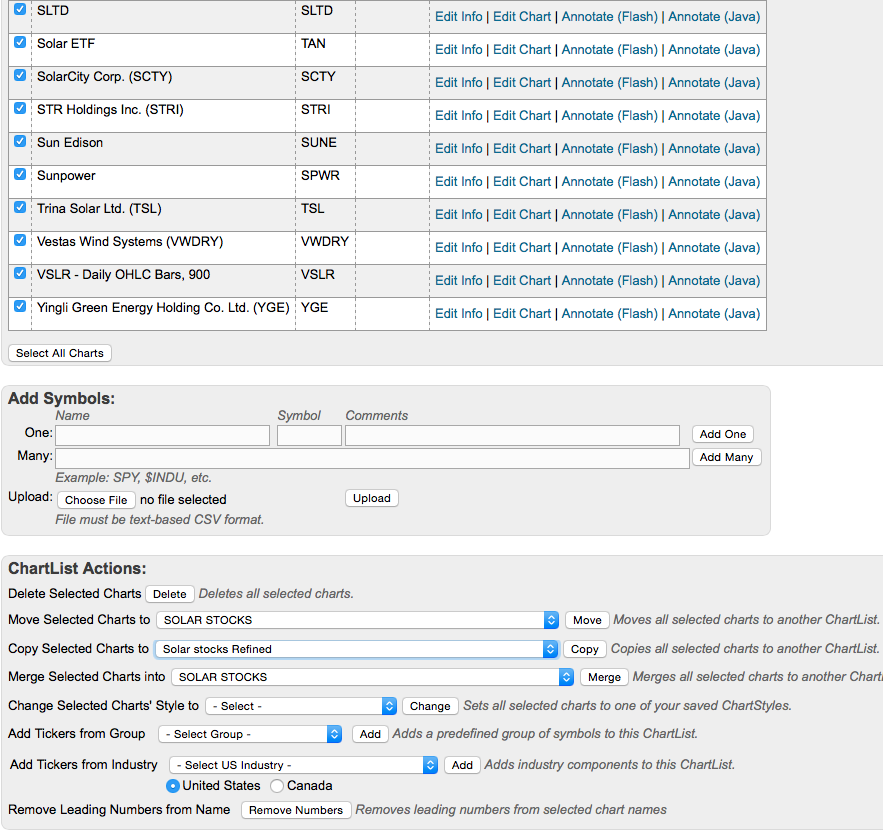
So now I must move to the new ChartList with all my charts in it so I don't delete the charts in the master list. You can see that below. The page is not long enough for you to see the whole list, but I want to make sure that you are in the right ChartList (Solar stocks Refined). When you use the copy command, it does not force you out of the old list (SOLAR STOCKS) onto the new one (Solar stocks Refined).

Now, I want to delete everything under $5. Let's change the view to summary view so we can see the price. Then click on the word 'close' at the top of the box to sort by price.
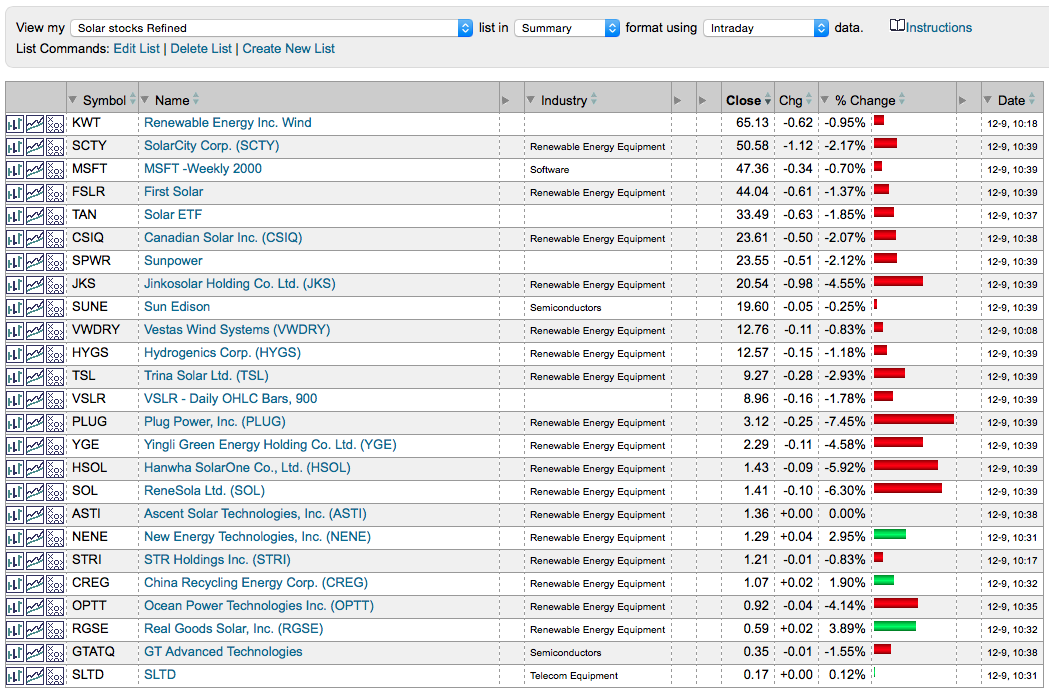
So I want to delete everything from Plug Power (PLUG) down. Write down the ticker symbols on a sheet of paper that we want to toss out of this list. Now go back up to the top and click on Edit list. Highlight all the companies we want to delete. The list should look like this.

OK. At the bottom click 'delete all selected charts.' This is why we want to have a separate chartlist. It literally throws them out and some day in the future we would have to go recreate a complete renewable energy stock list. When you click on delete, you should get a pop up box that warns you as shown below. Click OK.
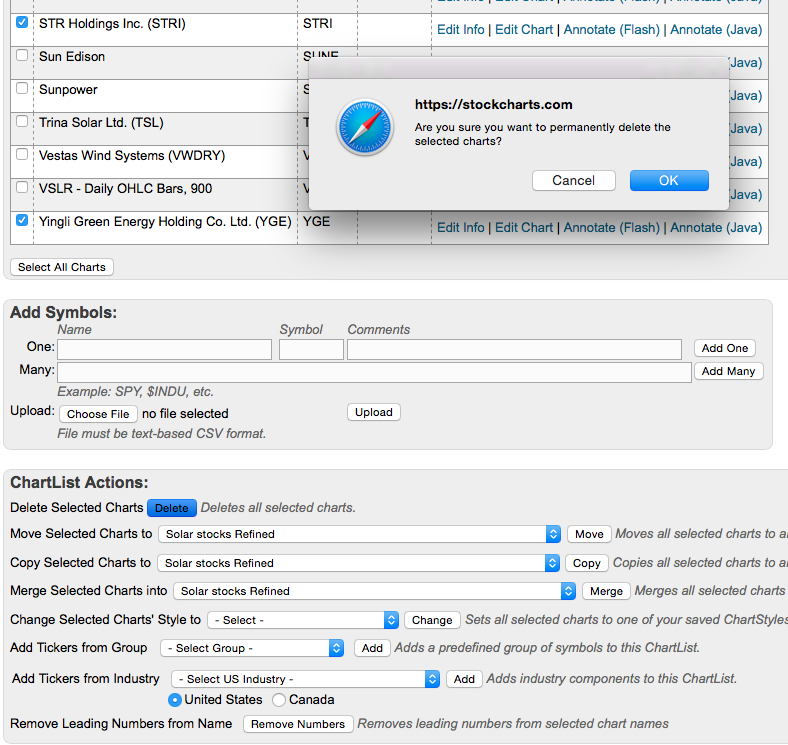
Excellent. Now let's look at our list in Summary view again. Change the dropdown box at the top to 'Summary.' This is the list below.
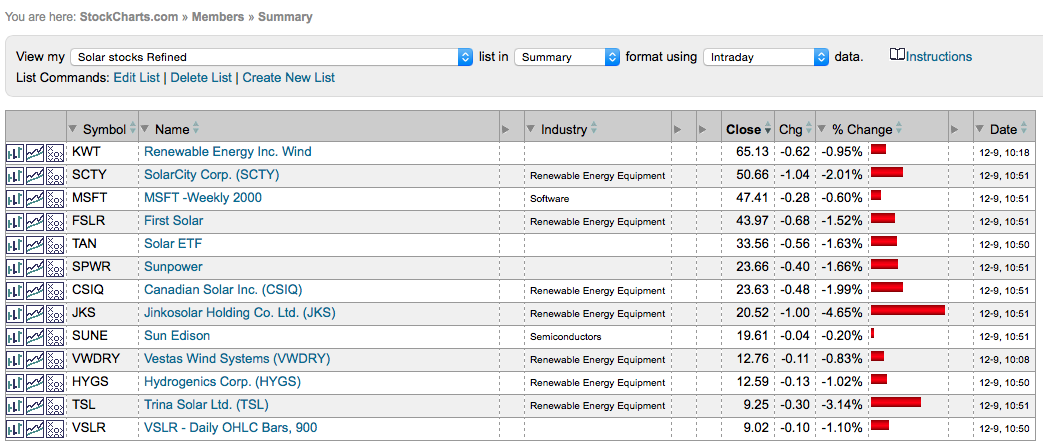
Starting at the top, we have KWT which is a renewable energy ETF. How smart is that, calling it Kilowatt for short! We'll keep the ETF. Next is Solar City (SCTY). Yep, let's keep that one. MSFT? What? More on that later. First Solar (FSLR). That qualifies. It is one of the oldest publicly traded solar stocks. TAN is an ETF for solar stocks. How dazzling is that ticker symbol? Who makes this stuff up? Anyway, I can remember TAN so that's great. Sunpower (SPWR) should stay on the list. Canadian Solar (CSIQ) is good. Jinkosolar (JKS) is good. Sun Edison (SUNE) is growing in the space so that is good. Vestas Wind Systems is an interesting chart so we'll keep it today and delete it when we get through the charts. Hydrogenics (HYGS) does not fit so 'right click' on the title, open the chart in a new tab, and click delete right at the top above the middle of the chart under the dropdown box. Come back to the working chartlist tab and we are going to keep Trina Solar (TSL) and Vivint Solar (VSLR). We need to fix the name of that one as we can't see it (only the ticker is showing on this list), so click on the chart and click 'save' in the top centre. Type in the Company name' Vivint Solar' and click save. You can see this below.
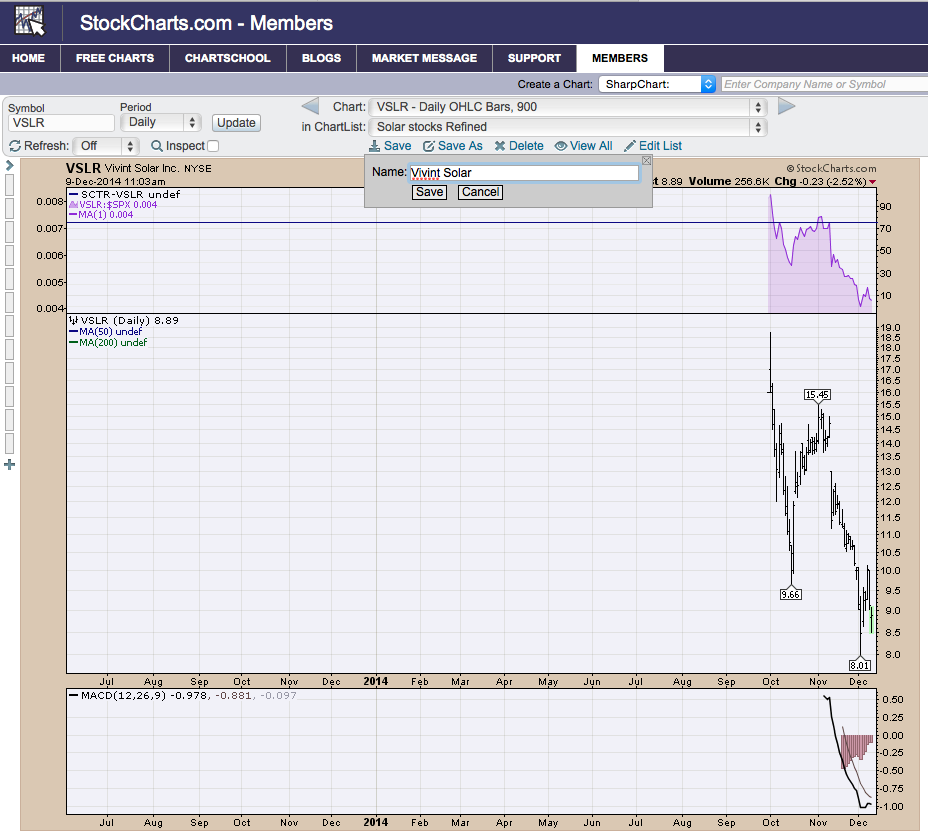
Now we have a tight list with two exceptions. Microsoft and Vestas. Why do I have MSFT in this list? The sun has started to shine on MSFT? No. That's not it. Here is a video as part of the Solar series I did with David Dodge. Remember it was done the last week of September 2014. This leads me to why I think Solar stocks are at an interesting place right now.
Now that you have watched that, we need to look at each chart. We'll do that in Part 3.
Good trading,
Greg Schnell, CMT






